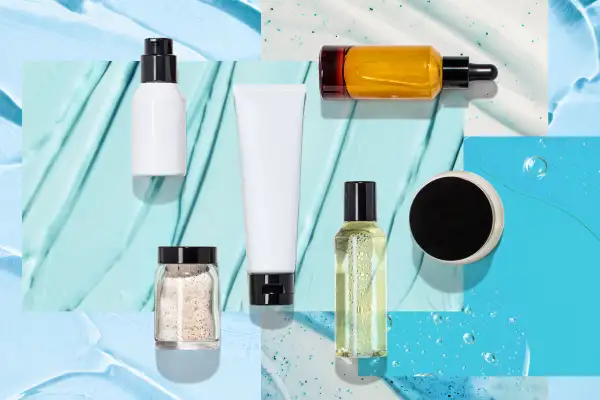The Hidden Costs of Buying Fake Cosmetics on Sites Like Amazon

Beata Dul’s lips were drier than sand.
The 25-year-old New Jersey resident had purchased a Laneige Lip Sleeping Mask, a favorite among Korean beauty product enthusiasts, from Amazon a few days earlier.
The leave-on lip mask is meant to “soothe and moisturize” users’ lips — which more than 10,000 4- and 5-star reviews on Sephora.com (plus more than 1,500 on Laneige’s official website) and plenty of gushing on beauty forums attest to. So why was it having the opposite effect on Dul?
"I thought maybe it just needed some more time to work," she says. But her lips only got worse.
Dul usually shops for her skincare products at household beauty retailers like Sephora, she says, but rave reviews of the Laneige product from a coworker convinced her to turn to Amazon, where she could get it delivered in less than two days. At the time, Laneige and its parent company, Amorepacific, didn’t have any "authorized sellers" on Amazon, meaning all the brand's products available on the site were sold through third-party vendors. Dul bought her lip mask from a vendor whose page has since become inactive, and while the product looked exactly like it was supposed to—a cotton candy-colored putty in an opaque glass jar—Dul believes she got duped. And she's not the only one.
Thanks to the rise in sales on e-commerce platforms like Amazon, counterfeiting luxury products has become a “highly profitable venture,” according to the Department of Homeland Security. The cosmetics industry loses more money to counterfeit products each year than any other industry, losing around $5.4 billion each year to fraudulent sellers, according to a report from the Organisation for Economic Cooperation and Development (OECD).
Amazon, for its part, "strictly prohibits the sale of counterfeit products," and "invest[s] heavily in both funds and company energy" to enforce the policy, according to a company spokesperson.
Still, over 42% of items purchased during a 2018 government investigation of third-party vendors on sites like Amazon and Walmart were fakes. Every single cosmetic item purchased in the investigation was believed to have been a counterfeit, including an Urban Decay eyeshadow primer that was a near-exact replica of the actual product.
The rise in counterfeit cosmetic goods is dangerous for consumers’ health — and their wallets.
Counterfeiters aren't beholden to customer complaints, and the goods they peddle go unchecked by federal regulators like the Food and Drug Administration. So buyers run a much higher risk of coming into contact with ingredients that cause allergic reactions or contain toxic materials.
The FBI has found some counterfeit products to carry carcinogens like arsenic, beryllium, and cadmium, all of which can cause serious internal and external damage. Some counterfeits seized by law enforcement have also tested positive for high levels of bacteria and human waste. More invasive cosmetic treatments, like the ultra-dangerous fake “DIY” facial fillers, have led to consumers injecting themselves with silicone that hasn't been designed for human use, which must be surgically removed.
“Several worrisome and even dangerous reactions are possible,” says Dr. Robert Anolik, a New York-based cosmetic dermatologist. “The reactions could be pink, scaly, itchy, painful, blistered, swollen and even disfiguring.”
In a best-case scenario, any unsightly physical reaction to unregulated ingredients can be cleared up with items you have at home (in Dul’s case, her lips returned to normal after a few days of applying Blistex.). But more extreme reactions, like discoloration or scarring, could require intense, expensive medical treatments — steroids, professional wound care, or even laser therapy, which could cost “hundreds to thousands of dollars to address,” Anolik says.
Online sales of cosmetics—both legitimate and otherwise—have been on the rise for the last decade. As the global response to COVID-19 temporarily shut down the majority of brick and mortar shopping, the cosmetics industry saw a drastic increase in online sales of at-home self-care and beauty products. Nail care purchases shot up the most, at 218%, followed by hair coloring (172%) and bath-and-body products (65%), according to a May 2020 report from McKinsey & Company. As demand skyrocketed, the pandemic threw a wrench in the supply chain of many cosmetic brands, creating the perfect conditions for scammers to cash out.
“Counterfeits are never out of inventory,” says Daniel Shapiro, Vice President of Brand Relationships at Red Points, a company that uses cloud-based programs to protect brands’ intellectual property.
Beauty scammers can make counterfeit versions of anything, but they tend to target luxury cosmetics, especially products that are in high demand. M.A.C. make-up knockoffs are especially common due to the simple design of their products. Claims of people getting ripped off by fake Kylie Lip Kits, one of the most popular products of Kylie Jenner's cosmetic line, flooded the internet in 2016, while sellers on eBay often peddle fake “samples” of Creme de La Mer, whose products normally retail for $345 at Sephora.
Since March 2020, Shapiro says the cosmetic brands he works with have dealt with an 85% increase in counterfeits. And that’s caused a blow to the reputations of many legitimate vendors.
Most people who buy counterfeits don’t actually know that the item is fake — and even if they do, one negative experience can put consumers off of the real brand for life. (Dul, for one, says she has yet to purchase any other products from Laneige, on Amazon or otherwise).
To combat the confusion, brands like Deciem, the parent company of the cult-favorite skincare line The Ordinary, provide a robust overview on their websites of every in-person shop and verified online retailer consumers can shop for their products. One quick search for ‘The Ordinary’ on Amazon gives you close to 200 product results — yet Amazon isn’t listed as a member of the company’s retailer network, making it impossible for shoppers to know whether their product is authentic or not.
Making these types of disclosures easily accessible can help shoppers make good, safe decisions when it comes to buying cosmetic products online. If you’re in the market for a new retinoid cream, or just looking to replenish your make-up supply without breaking the bank, here are some additional steps to avoid getting duped.
Wondering if your email has been compromised in a data breach? Find out with Money's new data breach tool!
How to Spot Counterfeit Products
In the golden age of online shopping, scammers have become incredibly sophisticated in their operations. With more and more boutique beauty brands and new lines from large companies launching on a regular basis, Shapiro says, scammers can create seemingly legitimate vendor profiles and begin touting counterfeit products within a few days.
Luckily, there are a few straightforward ways to find out if you’re going to get the real product before you press “Buy Now.”
Compare Prices
An old adage bears repeating: if something seems too good to be true, it probably is. If a product is discounted at Amazon, Shapiro says, you can typically find similar price cuts on the brand’s official website or their official distributors’ platforms.
If a serum from a luxury brand costs $50 across most platforms, but one independent seller on Amazon is offering the item for $25, something might be off. This is especially true if it’s a highly sought-after item: When a product is in high demand, most legitimate sellers want to make as much profit as possible.
If you can’t afford to spend money on a full-priced item, it’s best to hold off until a trustworthy retailer like a department store or the company itself places it on sale. In many cases, you can even set up text or email alerts through a company like Sephora or Nordstrom’s website for when the product is in stock and on sale.
Talk to Customer Service
It’s not always easy to tell from a quick glance if an item is legitimate or not. Still, if you suspect the beauty product you’ve purchased is a fake, look at the packaging and compare it to the details on the company’s official website. Do the ingredients match? Are the colors, fonts and designs the same? Does the texture or scent of the product itself seem different than what the description says?
If anything seems off, contact the brand’s customer service team. They can confirm whether a retailer is an authorized distribution partner and may ask that you send them the possible knockoff so they can find out for sure. If you bought the item through a marketplace platform like Amazon or Walmart, contact their customer service team as well. They can do an investigation into the legitimacy of the vendor, and no matter what the outcome is, you'll probably get a refund.
Get Help From Tech
Have you ever bought an item solely because it had thousands of rave reviews, only to find its quality to be mediocre at best? Many of those five stars are probably phony.
There are multiple apps and browser extensions that can help consumers sniff out fake reviews and illegitimate third-party sellers. One option is a browser extension like Fakespot which can scan ecommerce websites in real time as you browse, and generates a letter grade for the legitimacy of each product and its reviews. It can also alert consumers of similar products with better scores and prices.
More from Money:
How to Stop Spam Calls and Texts for Good
The Best Identity Theft Protection Right Now

